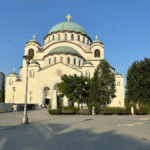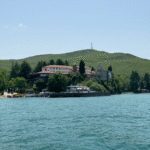As a guide who has spent over two decades leading travelers through the vibrant streets of Sarajevo, Dubrovnik, and Belgrade, the phrase “powder keg” often comes up. Visitors see the beauty, feel the incredible hospitality, and find it hard to reconcile the peaceful region of today with the volatile reputation it had a century ago.
So, why did the Balkans earn this explosive nickname? The answer isn’t a single event, but a perfect storm of collapsing empires, rising ambitions, and great power rivalries that made the region incredibly unstable.
The Quick Answer: What Was the “Powder Keg”?

The Balkans were called the “Powder Keg of Europe” because of the extreme political and ethnic tensions that built up in the region in the late 19th and early 20th centuries. Like a barrel of gunpowder, it only needed a single spark to explode into a massive conflict—which it did, triggering World War I.
The “powder” was a mix of three key ingredients:
- The Crumbling Ottoman Empire: A centuries-old empire was losing its grip on the region, creating a dangerous power vacuum.
- A Surge of Nationalism: The diverse ethnic groups in the Balkans (Serbs, Croats, Bulgarians, etc.) all wanted to form their own independent nations.
- The Meddling of Great Powers: Larger European empires, like Austria-Hungary and Russia, were interfering in the region to advance their own strategic interests.
The Ingredients of the Powder Keg: A Deeper Look
To truly understand the metaphor, you have to look at each component that made the situation so dangerous.
1. The Power Vacuum: The “Sick Man of Europe”
For 500 years, the had ruled over most of the Balkans. By the late 1800s, however, the empire was in terminal decline, often called the “Sick Man of Europe.” As its control weakened, the peoples it had once ruled began to fight for freedom. This created a chaotic and unpredictable situation where new borders were being drawn and old scores were being settled. There was no single, stable power to keep order.
2. The Sparks: A Fierce Rise of Nationalism
Imagine living under foreign rule for centuries and then suddenly seeing a chance for independence. This was the reality for dozens of distinct ethnic and religious groups. This powerful wave of was the main spark.
- Serbia dreamed of uniting all South Slavs into one nation (a “Yugoslavia”).
- Bulgaria, Greece, and Montenegro also wanted to expand their territories.
- Groups like the Albanians and Macedonians also sought their own states.
These competing ambitions meant that even after pushing the Ottomans out, these new nations often fought fiercely with each other over territory, as seen in the Balkan Wars (1912-1913).
3. Fanning the Flames: The Great Powers Intervene
The instability in the Balkans was a huge concern for the major empires of Europe, who all had competing interests:
- Austria-Hungary: A massive, multi-ethnic empire itself, it feared the rise of Slavic nationalism (especially from Serbia) would inspire its own Slavic subjects to rebel. It took control of Bosnia and Herzegovina in 1878 at the , which infuriated Serbia.
- Russia: Saw itself as the protector of the Slavic and Orthodox peoples of the Balkans. It supported Serbian ambitions as a way to gain influence in the region and access to the Mediterranean Sea.
This turned the Balkans into a proxy battleground. Russia and Austria-Hungary were essentially playing a high-stakes chess game, using the small Balkan nations as their pawns.
The Explosion: The Assassination in Sarajevo

The final spark that ignited the powder keg came on June 28, 1914. When I guide a through Sarajevo, I always stop at the Latin Bridge. It’s a peaceful spot now, but it’s where a Bosnian Serb nationalist assassinated , the heir to the Austro-Hungarian throne.
This act of protest against Austro-Hungarian rule gave the empire the excuse it needed to crush Serbian nationalism once and for all. It declared war on Serbia. Russia, Serbia’s ally, mobilized its army. This triggered a domino effect of alliances, and within weeks, all of Europe was engulfed in World War I. The powder keg had exploded.
The Balkans Today: From Powder Keg to Welcoming Destination
Over my two decades exploring this region, the most incredible thing I’ve witnessed is its transformation. The history is complex and the scars are real, but the “powder keg” is a relic of the past.
Today, the Balkans are one of Europe’s safest and most exciting destinations. The fierce independence that once fueled conflict now fuels a vibrant cultural pride. When you travel here, you’re not just seeing beautiful landscapes; you’re witnessing the resilience of people who have emerged from a tumultuous history to create peaceful, welcoming nations. Exploring this rich history is a core part of our Balkan tour packages from the USA, offering a journey that is as educational as it is breathtaking.


